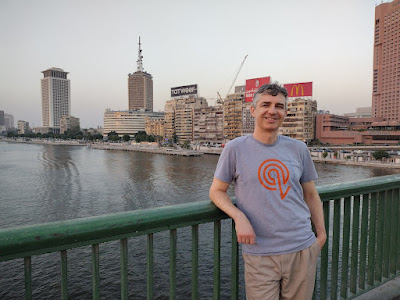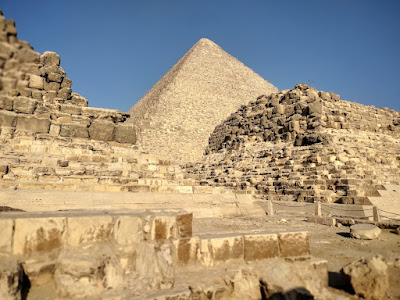Pharaoh Sneferu improved on the design of the Step Pyramid at Sakkara by putting a smooth facade to make the triangular side walls flat rather than in steps.
Another change put the burial chamber in the pyramid itself, reached by a secret passageway, rather than putting the mummified body in a pit in the ground, covered by a mastaba (with the Step Pyramid basically being a six-story mastaba).
However, Sneferu's first pyramid attempt failed despite an ingenious design that theoretically would support the massive weight of stone above the chamber by distributing the weight among the walls as they converged upward.
Something was wrong with the design, resulting in what at the time was the largest building in the world having walls that collapsed, making it unsuitable.
A new pyramid was begun, and again there was a problem with the design. This time, the pyramid was built too steeply, so a correction was made to decrease the angles of the walls from 54 degrees rising from the desert bedrock to 44 degrees at the top, but at least it was completed. The result is now called the Bent Pyramid.
Sneferu didn't give up, and his third pyramid, the Red Pyramid, was the first truly flat-walled pyramid.
 |
| The Red Pyramid is visible on the right, and the Bent Pyramid is a shadow behind the small pyramid. |
We could see these pyramids at Dahshur necropolis in the distance on our trip to Sakkara the prior day.
The next day, we had our first excursion with our tour group visiting the Great Pyramid, which was built by Sneferu's son Khufu. Khufu is also known by the Hellenized-name Cheops.
While Khufu is generally believed to be Sneferu's biological son, he might have been a son-in-law.
Keep in mind that hieroglyphics were not nearly as detailed as historical tomes of subsequent ages in that era only a few decades beyond pre-historic times. Much about history of the Pyramids and Pharaohs is guesswork
It is believed the Sphinx might have been built by Khufu as the grand entryway to his Pyramid complex.
What I can say for sure is that it is all quite impressive.
Unfortunately, the smooth material on the surface of the pyramids was mostly pillaged long ago to be reused on new construction in now ancient times.
The Great Pyramid originally reached 481 feet in height and has lost only a few feet with age, making it the tallest building in the world for about 4500 years. Its height wasn't surpassed until the Eiffel Tower was built in Paris for 1889's Exposition Universelle, a world's fair to celebrate the French Revolution's Centennial.
Our Tour Manager Fawzy had told us at our orientation meeting that if we wanted to go inside the Great Pyramid, we should book our tickets in advance. He explained that we should be pre-warned that it was a long walk through cramped space bent over, and that all the treasures had been plundered long ago.
He went on to say that the walls are rather plain, and that it would be very hot inside, adding that he was saying none of this to discourage anyone from doing it but only to set realistic expectations.
Julie and I decided to pass, although we did walk up to the entryway to take a look from there.
Laszlo signed up to go inside.
He said it was pretty much as described, including the one area where the height opened to allow standing upright with plenty of headroom.
While Laszlo explored inside the Great Pyramd, Julie and I walked around the grounds outside checking out more of the complex. There was a smaller pyramid which we could also enter, and we had decided that would be better for us. Laszlo caught up with us a few minutes before we found that entrance.
The cramped walk was not nearly as long as in the Great Pyramid, but it proved to be more than enough for me. As in the Great Pyramid, it was hot and cramped. Julie had her fill early, but Laszlo and I continued to the inner chamber, which we had to ourselves. Once again, no decorations on the wall, but it was worth experiencing.
While we all imagine we would like longer at different sites, a good tour schedule will give travelers enough time to appreciate places visited without getting bored or, in the case of Egypt where temperatures approached or surpassed 100 degrees Fahrenheit, fainting from heat.
Fawzy then took us over to a nearby plateau from which we could get good panoramic photos of the Pyramids, plus the promise to introduce us to a reputable camel owner to have our pictures taken.
Julie didn't want to get on the camel, but the assistants either didn't understand her or simply tricked her intentionally, and the next thing she knew she was sitting on a camel as it staggered to its feet.
There might have been a little yelling, but soon there was a smile, quick photos and back to the ground safe and sound.
In all fairness, one of our friends on the tour, a young woman named Tamara, screamed much louder than Julie, who after the initial shock took it good naturedly.
Laszlo thought twice about sitting on the camel after watching her, but I would say getting a photo with camels is a must-do in Egypt.
The camel wrangler recommended by Fawzy charged $1 to take a photo next to a camel and $2 for a photo on the camel, and it was money well spent, in my opinion.
You shouldn't underestimate the value of knowing where to go and what to do once you get there.
Fawzy had our group pose for a group photo, and then he later gave a copy to every couple or solo-traveler booked on the tour.
Our next stop was another must-do in Egypt.
The Sphinx is as iconic as the Pyramids for me. We've all seen it in movies and pictures, but there is something very cool about being there.
Our photos make it look less crowded than it actually was when we were at the Sphinx.
According to Fawzy, this was the busiest he had ever seen several of the ancient landmarks we visited, but somehow he helped us find ways to see it all, providing interesting commentary as we went.
I would guess the attack by Hamas on Israel will relieve tourist crowding in the area for awhile, which could be favorable for those who go to the Middle East during the next few months. There's always a silver lining to be found. When you think about it, there has been trouble somewhere in the world for decades, but life goes on.
On our way out of the Sphinx complex, I found a straw fedora that fit, so I purchased that for $10 as my shade hat for Egypt. As the vendor walked away, he said in English, loud enough for other prospective shoppers to hear, "You got a good deal, that hat for $15."
This being our final evening in Cairo, Julie wanted to walk over to a church we could see just beyond the Marriott's walls. It wasn't that impressive, although they did have an appropriate mosaic picture of Mary and Joseph fleeing with baby Jesus to Egypt, with pyramids in the background.
Still, Julie was soon ready to return to our lovely hotel oasis.
Laszlo wanted to go for a walk to the Cairo Tower, so I decided to accompany him on a long walk on this warm evening.
Our hotel was located on an island in the Nile between Cairo and Giza, which Fawzy said was one of the safest places for tourists in Cairo, but I thought it couldn't hurt for him to have a companion.
Fawzy said his biggest concern was traffic while crossing the street.
We had no hassles on the walk and avoided getting run over.
We enjoyed a nice stay in Cairo, and obviously you could see quite a few amazing sites on an all-day port excursion to this region from a Mediterranean cruise, if a full vacation in Egypt seems like too much for you.



















































































No comments:
Post a Comment